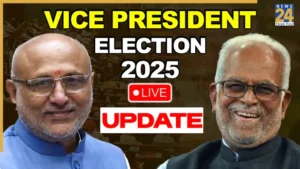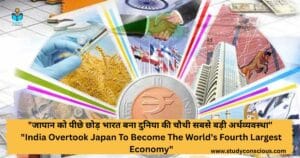Omar Abdullah is a prominent political leader from Jammu and Kashmir, a former Chief Minister, and a key figure in the National Conference (NC) party. Below is a properly arranged overview of his political background and the speculation about his future role:

Who is Omar Abdullah?
Family Background:
- Omar Abdullah was born on March 10, 1970, into a prominent political family. His grandfather, Sheikh Abdullah, was a key leader in Jammu and Kashmir’s history and served as the Prime Minister (later Chief Minister) of the region. His father, Farooq Abdullah, also served as the Chief Minister of Jammu and Kashmir multiple times.
Education and Early Career:
- Omar was educated in India and abroad, completing his education at the University of Strathclyde in Scotland.
- He entered politics at a young age, being elected to the Lok Sabha (lower house of India’s Parliament) in 1998.
Ministerial Roles:
- Omar Abdullah served as the Minister of State for External Affairs in the Atal Bihari Vajpayee government from 2001 to 2002.
Chief Minister of Jammu and Kashmir (2009–2015):
- Omar Abdullah became the Chief Minister of Jammu and Kashmir in 2009, leading a coalition government between the National Conference and the Congress Party.
- His tenure saw significant challenges, including managing the security situation and political unrest in the region.
Post-2019 Politics:
- Following the abrogation of Article 370 in 2019, Omar Abdullah was among several regional political leaders who were detained by the government. He was released in March 2020.
- Since his release, Omar has been vocal about restoring Jammu and Kashmir’s statehood and political rights, and he remains an influential voice in the region.
Is He the Next Chief Minister?
- Speculation on Future Role:
- While there has been no confirmation regarding the next election in Jammu and Kashmir, Omar Abdullah remains one of the strongest contenders for the role of Chief Minister if elections are held in the future. His leadership within the National Conference and the party’s historical influence in the region positions him as a key candidate for the role.
History of Jammu and Kashmir
Ancient and Medieval Periods
- Early History:
- Jammu and Kashmir were historically part of various Hindu and Buddhist empires. It was mentioned in ancient texts such as the Mahabharata.
- In the 3rd century BCE, it became part of the Mauryan Empire under Emperor Ashoka, who introduced Buddhism to the region. It later became a center for Buddhist learning.
- Kushan and Gupta Empires:
- The region flourished under the Kushan Empire (1st–3rd centuries CE), with Buddhism continuing to thrive.
- During the 4th and 5th centuries, it came under the control of the Gupta Empire.
- Hindu and Buddhist Rule:
- From the 7th to 10th centuries, the region saw the rise of various Hindu and Buddhist dynasties, including the Karkota and Utpala dynasties.
- The region’s most famous king during this time was Lalitaditya Muktapida of the Karkota dynasty, who expanded his empire across northern India.
Islamic Influence and Sultanate Period
- Introduction of Islam (14th Century):
- In the 14th century, Muslim Sufi missionaries and scholars began arriving in Kashmir. Islam slowly spread in the region, and by the late 14th century, it had a significant influence.
- Shah Mir Dynasty (1339–1561):
- The first Muslim ruler of Kashmir, Shah Mir, established the Shah Mir dynasty in 1339. He and his successors ruled for over two centuries, marking the region’s transition to Islamic rule.
- Mughal Rule (1586–1751):
- In 1586, Kashmir was incorporated into the Mughal Empire under Emperor Akbar. The Mughals beautified the region, building gardens and forts. Mughal emperors often visited Kashmir, and it became known as a “paradise on earth” for its natural beauty.
Afghan and Sikh Rule
- Afghan Durrani Rule (1751–1819):
- After the decline of the Mughal Empire, Kashmir fell under Afghan rule in 1751. Afghan governors ruled harshly, which led to widespread discontent among the local population.
- Sikh Rule (1819–1846):
- The Sikhs, under Maharaja Ranjit Singh, captured Kashmir in 1819. The Sikh Empire controlled the region until 1846, introducing reforms and bringing some stability to the region.
Dogra Dynasty and British Period
- Treaty of Amritsar (1846):
- After the First Anglo-Sikh War, the British sold Kashmir to Gulab Singh, the Dogra ruler of Jammu, under the Treaty of Amritsar. He became the Maharaja of Jammu and Kashmir and established the Dogra dynasty.
- Dogra Rule (1846–1947):
- The Dogra dynasty ruled the princely state of Jammu and Kashmir under British suzerainty. Maharaja Hari Singh was the last Dogra ruler.
- During the Dogra period, the state was composed of diverse regions—Jammu, Kashmir, Ladakh, and Gilgit-Baltistan, each with its unique culture and population.
Partition and Accession to India
- Partition of India (1947):
- In 1947, when India was partitioned, the princely state of Jammu and Kashmir had the option to join either India or Pakistan. Maharaja Hari Singh initially sought to remain independent.
- In October 1947, Pakistani tribal forces invaded Kashmir. Maharaja Hari Singh requested military assistance from India, signing the Instrument of Accession, which led to Kashmir becoming part of India.
- First Indo-Pakistani War (1947–1948):
- Following the invasion, India and Pakistan went to war over the region. The conflict ended in 1948 with a UN-brokered ceasefire, leaving Jammu and Kashmir divided between the two nations.
- India retained control over about two-thirds of the region (Jammu, the Kashmir Valley, and Ladakh), while Pakistan controlled the rest (now called Azad Jammu and Kashmir and Gilgit-Baltistan).
Post-Independence and Modern Era
- Article 370 and Special Status:
- In 1949, Article 370 was added to the Indian Constitution, granting special autonomy to Jammu and Kashmir, allowing it to have its own constitution and a high degree of administrative independence.
- Despite this, the region saw decades of political instability, with demands for greater autonomy, independence, or merger with Pakistan by various groups.
- Indo-Pakistani Wars and Insurgency:
- The region has been the flashpoint of several wars between India and Pakistan (1965, 1971) and has witnessed insurgencies since 1989, which intensified the conflict in the Kashmir Valley.
- Abrogation of Article 370 (2019):
- On August 5, 2019, the Indian government, led by Prime Minister Narendra Modi, revoked Article 370, ending Jammu and Kashmir’s special status. The state was bifurcated into two Union Territories—Jammu and Kashmir, and Ladakh.
Present Situation
- Jammu and Kashmir continues to be a disputed region, with India, Pakistan, and China holding different portions of the territory.
- The political future of the region remains uncertain, with periodic unrest, military presence, and demands for autonomy or self-determination continuing to shape its politics.












Good job !!!